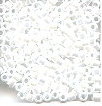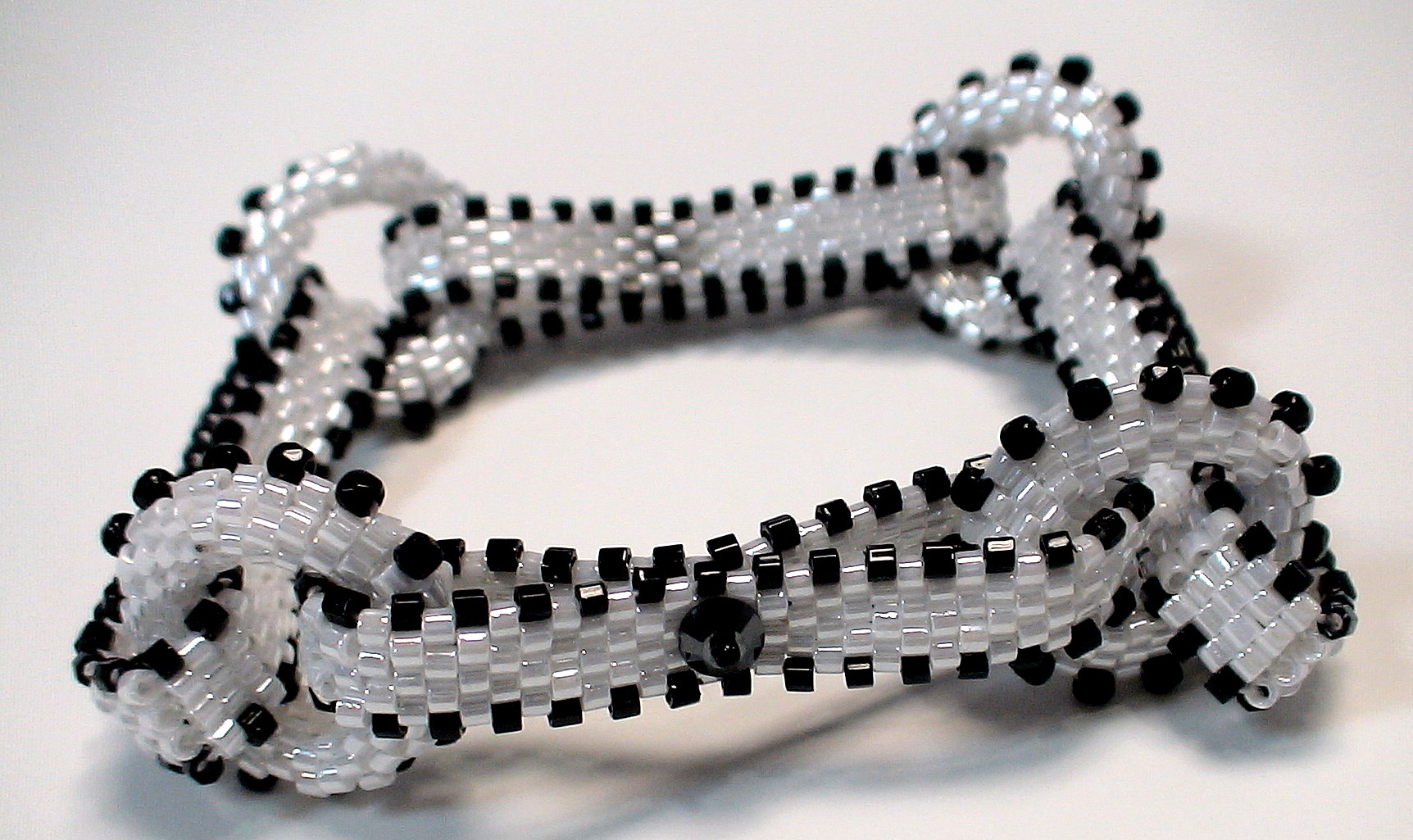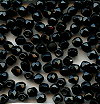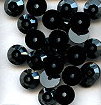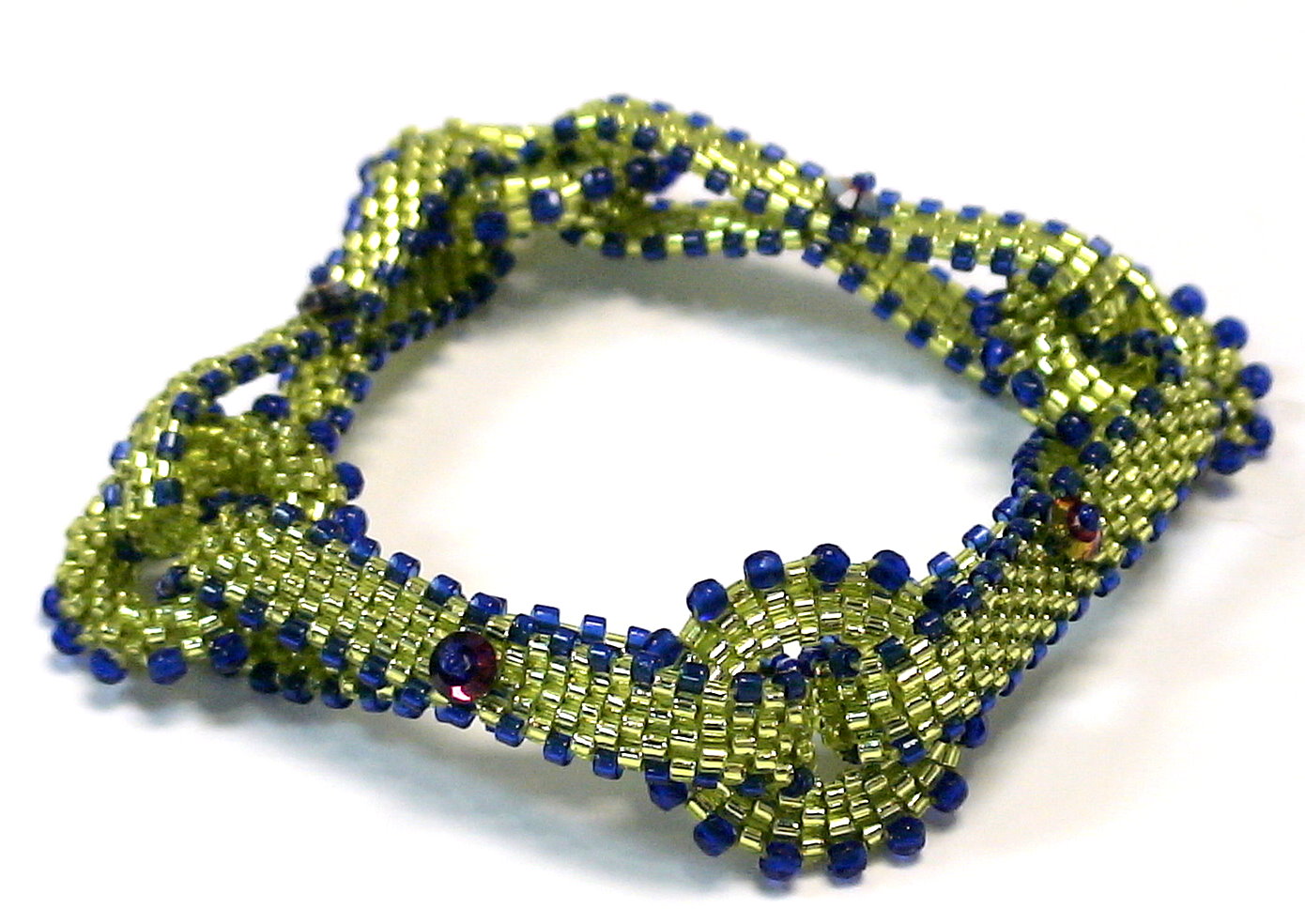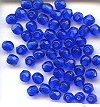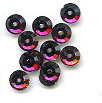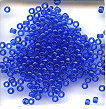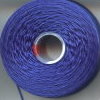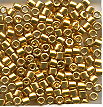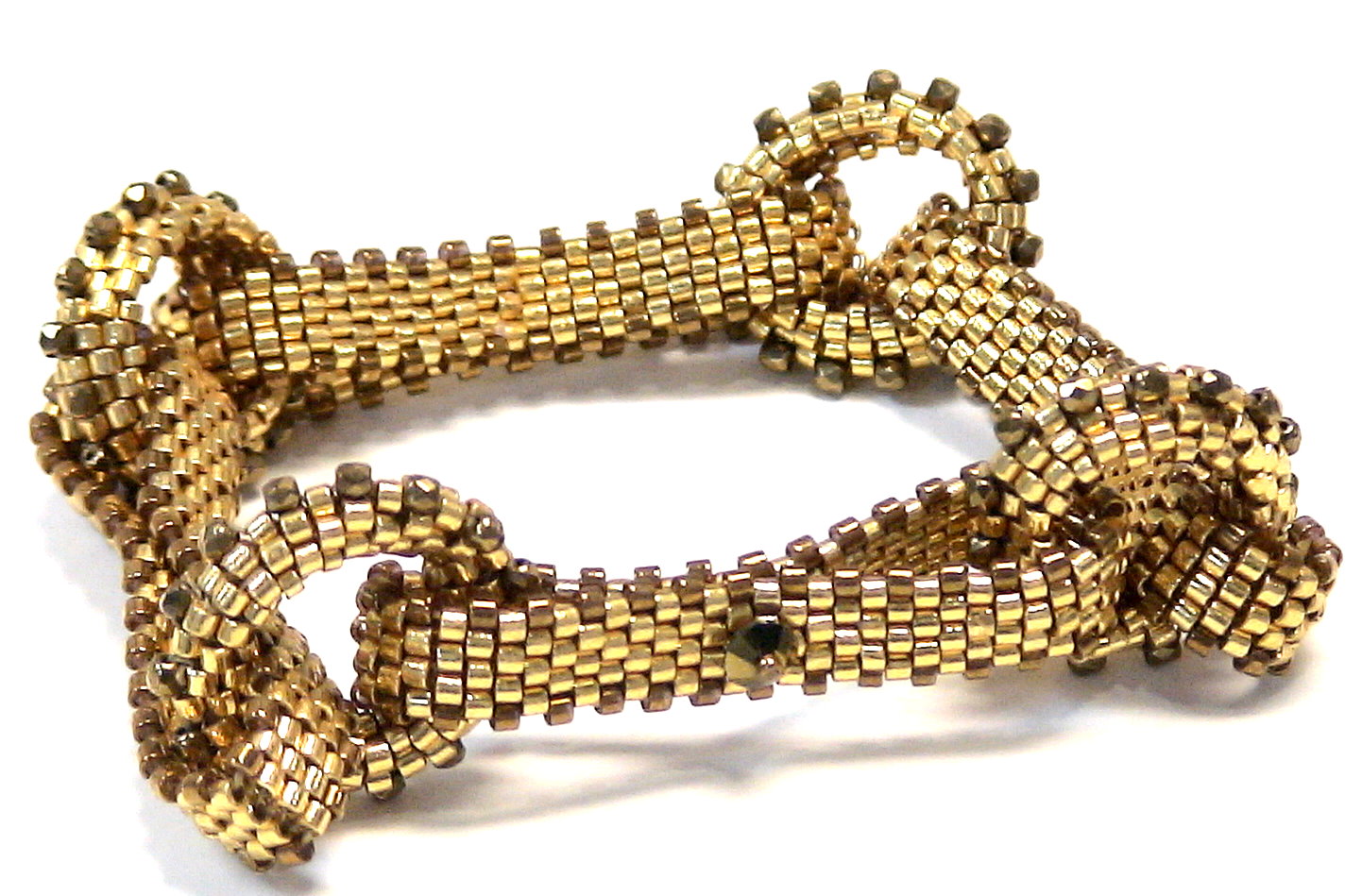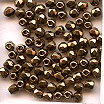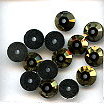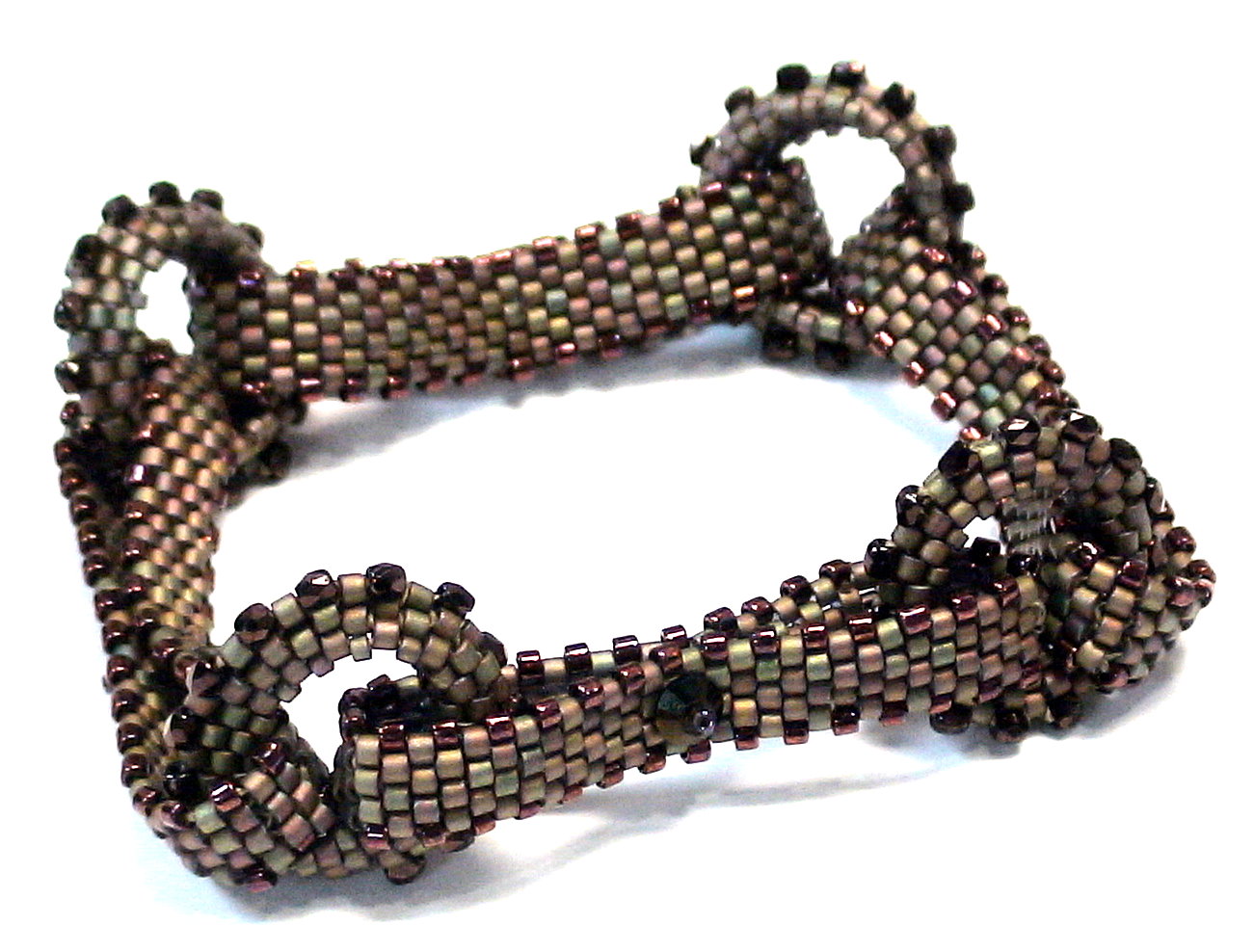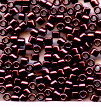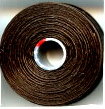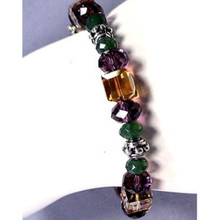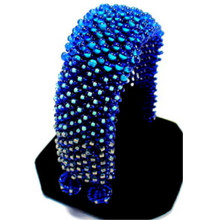Categories
Categories
- Home
- KITS
- BEAD WEAVING
- TUXEDO PARK BANGLE BRACELET INSTRUCTIONS DOWNLOAD, (1 unit)
TUXEDO PARK BANGLE BRACELET INSTRUCTIONS DOWNLOAD, (1 unit)
Product Description
Tuxedo Park Bangle Bracelet
Designed by: Warren Feld
BW1-SOM-06
BEGINNER LEVEL
-- Bead Weaving Sequence
-- Stitch of the Month
-- Lesson: Brick Stitch
-- Bangle Bracelet
Strut your stuff through Tuxedo Park on the East Side of Lower Manhattan! Learn how much shaping, interest and dimensionality you can achieve with the simple, basic Brick Stitch.
NOTE: Regular retail and wholesale store discounts do not apply to kits.
The TUXEDO PARK BANGLE BRACELET KIT
Instructions to make a 7" bangle bracelet
Supplies to make up to an 8" bangle bracelet
|
PLEASE NOTE: Sometimes, because of erratic supplies of beads and othermaterials,
we will need to substitute something of similar color and quality.
#1 BLACK & WHITE
|
Colors may appear differently on different monitors.
#2 CHARTREUSE AND COBALT
|
Colors may appear differently on different monitors.
#3 GOLD AND BRONZE
|
Colors may appear differently on different monitors.
#4 RASPY KHAKI
|
Colors may appear differently on different monitors.
FORMAT OPTONS
(1) Instructions Digital Download
About the Kit...
The Brick Stitch is historically is found in several cultures, but it is most associated with Native American beadwork. The Brick Stitch is where beads are woven and locked into place by snagging the thread loops between them. As you add a new bead, you snag the thread loop to pull the already completed rows up to the bead. The resultant look is like a brick wall.
For the Tuxedo Park Braceletproject we are doing here, I wanted to make a woman's bangle bracelet, about 7" long and about 3/4" wide, and which had a comfortable, somewhat loose fit on the wrist. I visualized a bracelet that would have a Chanel styling to it, with a limited 2-color palette, and a strong line or outlining in the design.
This is a project for beginners, so I wanted to start with doing the stitch flat. But I also wanted to show some versatility to the stitch, so in the course of making our 4 links, we vary the sizes of the beads, the number of beads per row, and whether we increase or decrease. We embellish the surface and edges in a way to create a sense of a continuous line.
Most versions of this bracelet use only 2 colors. In some versions, I use contrasting colors; in others, matching or coordinating colors. Because I use one of the colors to establish a very strong sense of "line" throughout the piece, more than 2 colors often makes the piece look too busy or awkward -- too much competing with that "line" which one of strongest design elements of the piece.
In the Tuxedo Park Bangle Braceletproject...
LearnToBead Goals:
- History of Brick Stitch
- Brick Stitch bead weaving basics
- Managing Thread Tension
- Reading a Pattern/Creating a simple Figural Representation
- Increasing and Decreasing with Brick Stitch
- Embellishing above your brick stitch base
- Varying bead sizes to create curvature
- Finishing off the edges
- Discussion of when Brick Stitch works well
- Making measurements when making a bangle bracelet (thus, when you do not use a clasp and the bracelet is meant to slip over the wrist)
TABLE OF CONTENTS:
This set of instructions is organized as a series of
Jewelry Design Choices:
SUPPLIES LIST, p. 3
I. Planning Your Project, p. 4
IA. Conceptualizing Your Piece, p. 4
IB. Measurements, p. 6
IC. Selecting Materials, p. 7
ID. Sketching a Pattern or Graph, p. 7
IE. Identifying Support Systems, p. 9
IF. Identifying Potential Areas of Weakness within Your Piece, p. 10
IG. Visualizing Your Process, p. 10
IH. Organizing Your Work Space, p. 13
II. Beginning Your Project, p. 14
IIA. Basic Steps, p. 14
A. Create a Long Link, p. 14
B. Create a Short Link and connect to the Long Link, p.22
C. Continue the Assembly for 4 Long Links and 4 Short Links, all interconnected into a bangle, p. 28
IIB. Dealing with Contingencies, p. 29
IIC. Finishing Touches, p. 31
III. Summary of Learning Objectives You Have Met
After Accomplishing This Project, p. 31
IV. Next Steps, p. 33
IVA. Suggested Readings, p. 33
| LEARNING OBJECTIVES | TUXEDO PARK BANGLE BRACELET Brick Stitch |
||
| BEGINNER | INTERMEDIATE | ADVANCED | |
| TECHNICAL MECHANICS | |||
| 1. Managing Thread Tension | BEGINNER | ||
| 2. Holding Your Piece To Work It | BEGINNER | ||
| 3. Reading Simple Pattern, Figure and/or Graph | BEGINNER | ||
| 4. Selecting Materials | BEGINNER | ||
| 5. Identifying Areas of Potential Weakness, and Strategies for Dealing With These |
BEGINNER | ||
| 6. Determining Measurements, including Width and Length of a Piece, Especially In Relationship To Bead Sizes | BEGINNER | ||
| 7. Finishing Off Threads in Piece or Adding Threads | BEGINNER | ||
| UNDERSTANDING CRAFT BASIS OF STITCH | |||
| 1. Starting the Stitch | BEGINNER | ||
| 2. Implementing the Basic Stitch | BEGINNER | ||
| 3. Finishing Off Your Piece With A Clasp Assembly | BEGINNER | ||
| 4. Creating Simple Surface Embellishment | BEGINNER | ||
| 5. Increasing and Decreasing | BEGINNER | ||
| 6. Working Stitch in Tubular Form | |||
| 7. Working Stitch To Create Open (Negative Spaces), and Split Forms | |||
| 8. Elaborately Embellishing the Stitch, including Fringes, Edge Treatments, Straps and Connectors | BEGINNER | ||
| 9. Working Stitch in Circular Form | |||
| 10. Working Stitch in 3-Dimensions | |||
| UNDERSTANDING ART & DESIGN BASIS OF STITCH | |||
| 1. Learning Implications When Choosing Different Sizes/Shapes of Beads, or Using Different Stringing Materials | BEGINNER | ||
| 2. Understanding Relationship of this Stitch in Comparision to Other Types of Bead Weaving Stitches | |||
| 3. Understanding How Bead Asserts Its Need For Color, Using This Stitch | |||
| 4. Creating Your Own Design with This Stitch, in Reference to Jewelry Design Principles of Composition | |||
| 5. Creating Shapes, Components and Forms with This Stitch, and Establishing Themes | BEGINNER | ||
| BECOMING BEAD WEAVING ARTIST | |||
| 1. Developing A Personal Style | |||
| 2. Valuing or Pricing Your Work | |||
| 3. Teaching Others The Stitch | |||
By completing a purchase of any of our kits and/or instructions, you agree to our terms and conditions:
1. Customers are allowed to make 3 copies of instructions for personal use
2. Permission is required from LandOfOdds.com, Be Dazzled Beads, or LearnToBead.net, when teaching for fees, with any of our projects
 Loading... Please wait...
Loading... Please wait... 


